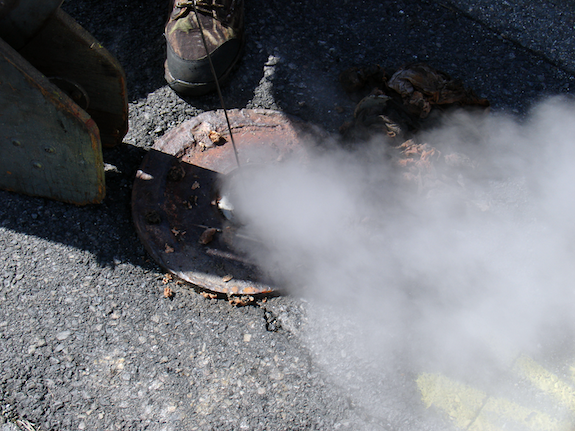Why People Won’t Leave the Town that Has Been On Fire for Fifty Years
For the residents of Centralia, Pennsylvania, the fire that has been burning beneath their town for fifty years is part of what makes it home.

A hole in Centralia’s street lets out the smoke from the fire beneath them. Image: Mredden
Centralia, Pennsylvania, has been on fire for about fifty years. Once a town of about a thousand, there are now eight people, in eight houses. The town doesn’t even have a zip code – that was taken away from them in 2002. Highway 61 has been diverted around the town, and its main street blocked off. But the eight people fight to stay – despite the landfill fire that crawled beneath them into an abandoned coal mine and set up shop. It has burned since it arrived.
The Smithsonian visited Centralia, and described it this way:
From the back kitchen window of his little house on a ridge in east-central Pennsylvania, John Lokitis looks out on a most unusual prospect. Just uphill, at the edge of St. Ignatius Cemetery, the earth is ablaze. Vegetation has been obliterated along a quarter-mile strip; sulfurous steam billows out of hundreds of fissures and holes in the mud. There are pits extending perhaps 20 feet down: in their depths, discarded plastic bottles and tires have melted. Dead trees, their trunks bleached white, lie in tangled heaps, stumps venting smoke through hollow centers. Sometimes fumes seep across the cemetery fence to the grave of Lokitis’ grandfather, George Lokitis.
Radiolab has a short about the town, and the history of its fire.
The residents claim the town is still safe, despite authorities’ warnings. In the 1980s, 500 structures were demolished and over 1,000 people were evacuated. The fire can cause sinkholes and seeps of toxic gases.
Now, the Pennsylvania government is trying to get those eight people out. But they don’t want to leave. The BBC sent a reporter to interview the remaining residents, and the results are fascinating.
Why do people hold on so long? The residents of Centralia aren’t so different from those who live in the tornado belt or on fault lines – places guaranteed to be in the middle of a natural disaster. There is a town in Russia called Verkhoyansk that is the coldest city in the entire world. The record low is minus 90 degrees Farenheight. Other people live at the foot of the Mount Merapi, a volcano that has erupted sixty times in the past 500 years. In Africa, Lake Kivu is called the “Lake of Death” for the 2.3 trillion cubic feet of methane gas, and 60 cubic miles of carbon dioxide trapped below its surface, slowly seeping out. Yet people live in all these places.
At Scientific American, Tim De Chant argues that living in places with intermittent disasters is hard wired into us.
We settled those places for good reason. What makes them attractive is the same thing that makes them dangerous. Periodic disruption and change is the progenitor of diversity, stability and abundance. Where there is disaster, there is also opportunity. Ecologists call it the “intermediate disturbance hypothesis.”
And yet, the fertile soil and water and access to ports isn’t as important today. For the most part, barring poverty or political strife, people living by the Lake of Death or in Centralia don’t have to live there — they chose to. At Smart Planet, Rachel James argues that it’s not about economics or cost-benefic analysis. “The story is a poignant reminder of how our homes, the places we are born into or decide to inhabit, deeply inform our sense of self.” For these residents, Centralia, fire and all, is home.
More at Smithsonian.com:
/https://tf-cmsv2-smithsonianmag-media.s3.amazonaws.com/accounts/headshot/Rose-Eveleth-240.jpg)
/https://tf-cmsv2-smithsonianmag-media.s3.amazonaws.com/accounts/headshot/Rose-Eveleth-240.jpg)